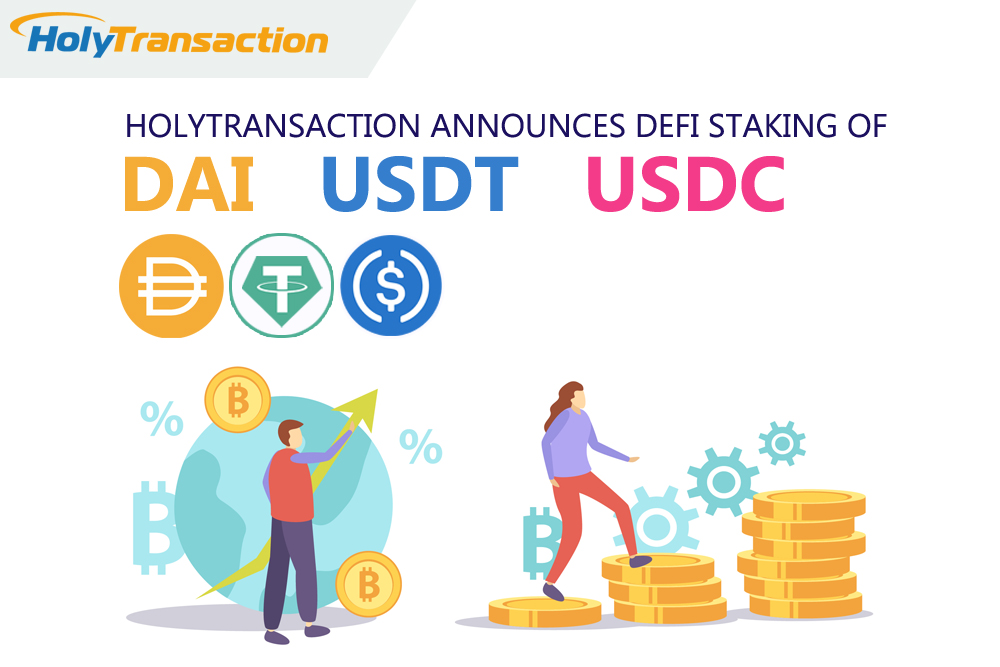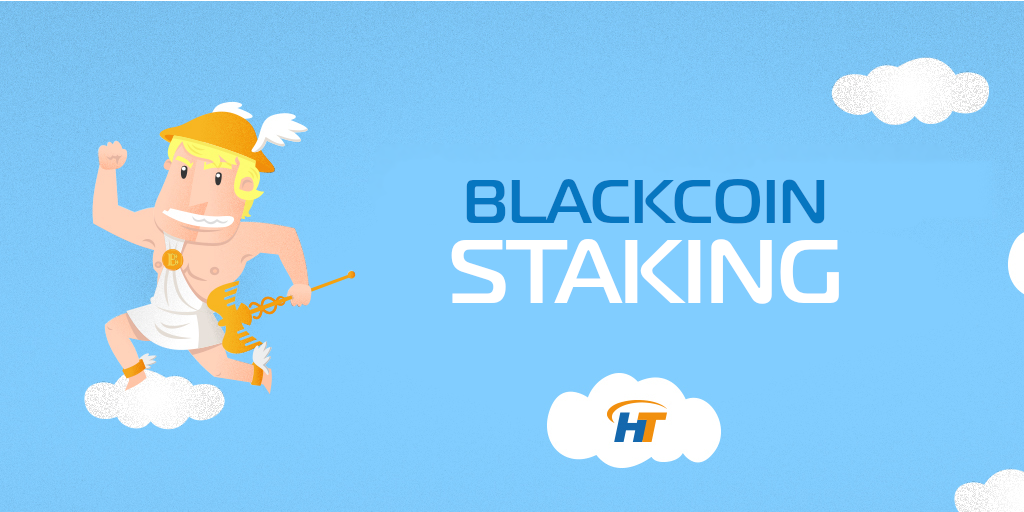

You can now leverage your ADA to help decentralize the Cardano network while earning financial rewards. Staking ADA has become much easier with HolyTransaction!
Key advantages to staking with HolyTransaction:
Navigate to Staking inside your HolyTransaction account and follow the provided instructions.
What is Cardano’s Proof-of-Stake (POS)?
In contrast to the proof-of-work consensus mechanism that Bitcoin uses, some cryptocurrencies use an alternative model for consensus called proof-of-stake. So instead of miners creating new coins and verifying transactions as in the proof-of-work model, you have what are called stakeholders. Stakeholders are rewarded for delegating their ADA to stake pools that are managing block production.
Open your free digital wallet here to store your cryptocurrencies in a safe place.


Decentralized finance is quite literally taking the entire blockchain industry by storm.
After a relatively slow buildup over the past few years, the spotlight has well and truly fallen on the cryptocurrency space’s ability to do what traditional finance does — but better.
HolyTransaction, the world’s most trusted cryptocurrency web wallet, is making access to DeFi solutions available to all of its users starting now.
How? HolyTransaction developers have integrated DeFi savings accounts for stablecoins into HolyTransaction web wallets.
If the whole decentralized finance thing is new to you, and you’re having trouble understanding the importance of cryptocurrency savings accounts with stablecoins, then read on!
Blockchain has promised to do a lot over the years.
However, at the end of the day, its first and best use case going back to the invention of Bitcoin is, and has always been, money.
If you’re looking for a one-liner, it’s this:
Cryptocurrencies do it better.
So, why shouldn’t cryptocurrencies one-up the traditional financial industry?
Decentralized finance refers to blockchain-based protocols that enable peer-to-peer financial solutions like loans and, yes, savings accounts. Anything the traditional financial industry offers via institutions like banks, you will soon be doing in a decentralized manner without third parties at all.
The truly clutch tool in the development of the #DeFi industry has been the stablecoin, a workhorse digital asset used to minimize value volatility by pinning a cryptocurrency’s worth to an outside asset.
Some stablecoins, like Tether (USDT), pin their value to government currencies such as the US dollar. To maintain value, $1 is stored in a reserve for every 1 USDT circulating in the open market.
Other stablecoins peg their value to assets like gold, oil, and electricity.
Today, stablecoins are gaining immense popularity as digitally-native alternatives to slow, centralized, and costly to use fiat currencies like the EUR, RUB, USD, and YEN.
When using traditional banking savings account solutions, you’ve probably noticed that APY rates are pretty low.
Even so-called high yield accounts don’t yield much with limits as low as 0.5%.
Decentralized finance is changing that. By removing third parties from banking scenarios, you can often earn as much as 3% APY by keeping your stablecoins in an interest-generating crypto savings account.
The great news is HolyTransaction has integrated such interest-earning features directly into its trusted cryptocurrency web wallets.
With HolyTransaction, there is no need to download, install, or otherwise figure out another piece of software.
Instead, you can use your HolyTransaction cryptocurrency web wallet directly via the web, allowing you to get started generating rewards on your stablecoins right away.
If you’re concerned about a learning curve of some kind — worry not.
Using a DeFi savings account is the same as using a basic cryptocurrency wallet. Just deposit your stablecoins, click on “stake” and you’re good to go — the longer you store them, the more they yield in return.
Want to get started today? Jump over to HolyTransaction to quickly create an account and start saving.
Open your free digital wallet here to store your cryptocurrencies in a safe place.


PIVX is a privacy-focused cryptocurrency that stands for “Private Instant Verified Transaction“. It is a fork of another cryptocurrency, Dash. Like Dash, PIVX is also used proof of stake for consensus. This means that there are opportunities for earning PIVX just by owning PIVX. This contribution to the network helps fund the verification of transactions and the creation of new PIVX coins. You can think of this as earning interest on your coin or as a dividend on your investment.
HolyTransaction.com is excited to present to you the launch of our new staking service. You can now leverage Proof of Stake (POS) holdings to safeguard crypto networks while earning financial rewards. Staking PIVX has become much easier with HolyTransaction!
The first step is to register on HolyTransaction.com to get your PIVX web wallet. The official PIVX wallet is available for Windows, macOS, as well as Linux. Android and iOS versions are also available, but these versions do not yet include staking functionality.
After accessing the HolyTransaction wallet, you must wait for your PIVX deposit to reach the minimum number of confirmations for the synchronization to finish. If you move your PIVX in staking before the next rewards distribution is done, your wallet will receive less rewards according to the mininum PIVX held in that time frame.
Once the PIVX address on Holtransaction has received the transaction, you will start staking yourself some PIVX. Your coins must have at least 101 confirmations. These coins are referred to as mintable coins. The number of confirmations on your transaction can be viewed in the history of your account. Once your coins are mintable, you will then be able to stake them and start receiving POS rewards, you can see your rewards in History -> Distributions. Staking can sometimes take as long as 24h to begin once all the prerequisites are met. If staking does not begin after some days, you should wait until you start minting blocks in your wallet.
The more PIVX you stake, the more rewards you get. If you have over 10,000 PIVX, this qualifies you as a masternode. This allows you some say in how the PIVX network operates and also qualifies you to receive additional rewards. Masternodes can earn up to 10% of their stake.
You can stake your coin without being online 24/7, but you will not be eligible for staking rewards while your system is offline. Unlike some other proof of stake coins, PIVX does not consider the age of the coins or the amount of time they have been staked. PIVX only considers is your PIVX balance.
HolyTransaction staking wallet makes it much more user-friendly to stake your POS cryptocurrencies. PIVX has great passive income potential, especially for those who hold over 1000 PIVX, this designation greatly increases the rewards you receive. To begin staking PIVX start by depositing your coins in your HolyTransaction Wallet.
Open your free digital wallet here to store your cryptocurrencies in a safe place.


Gridcoin is a cryptocurrency with ambitions of advancing scientific research. It was originally a simple hybrid of proof of work and proof of stake but now has developed its own custom mechanism blending elements of the two. New coins are created using Proof of Stake, but the number of new coins created depends on how much processing power was used for BOINC.
HolyTransaction Wallet is excited to present to you the launch of our new staking service. You can now leverage Proof of Stake (POS) holdings to safeguard crypto networks while earning financial rewards. Staking GRC has become much easier with HolyTransaction!
According to the PoR mechanism, If a node contributing its hash power to a project that has been whitelisted on the Berkeley Open Infrastructure of Network Computing (BOINC), that node will receive GRC coins corresponding proportionally with the amount of the work done by the node. The BOINC list contains projects of scientific importance that require a supercomputer but don’t have access to one. Of these projects, Gridcoin users vote on a subset of them to be whitelisted for contributions of computing power. Gridcoin, therefore, gives people all over the world the ability to contribute computing power to any of these projects and contribute to scientific research. You can also generate income by running Gridcoin in what the Gridcoin project calls “investor-only mode.”
Investor-only mode is what the Gridcoin project calls it when you setup earns proof of stake interest as opposed to the DPOR (proof of research) payments that “crunchers”—those who contribute computing power receive. You will only need to install the Gridcoin client and will not need the BOINC client.
The first step to setting up a Gridcoin client for investor-only mode is to install the Gridcoin Research client. The client is available for Windows, macOS, and several flavors of Linux including Debian, Arch Linux, OpenSUSE, and Fedora. Once the client has been installed, you will want to sync with the Gridcoin blockchain. This can take between several hours to a couple of days, depending on your internet speed. A green check on the connection bar indicates that the synchronization is complete. At that point, you can unlock your wallet for “staking only.” It can take up to 16 hours for the staking to begin. Running the Gridcoin client at all times maximizes your potential for income. Anytime the client is offline, you could miss an opportunity to mint a block.
The higher the balance you have, the higher the chances that you will get to “stake” a block. This is only a result of the fact that a higher balance gives you more chance to mint Pos blocks and thus you get a payout more often. While you can theoretically stake with any number of coins, you can only reliably stake with at least 2000 coins and the Gridcoin project itself recommends at least 5,000. The miners who contribute computing power to these projects come in two varieties—solo and pool. Pool miners earn research rewards whether they stake or not, but solo miners must stake in order to get paid.
Gridcoin provides a way to contribute to important scientific research and earn passive income while doing so. Even those who only stake coins and don’t provide actual computing power to these projects contribute by securing the network and helping the Gridcoin ecosystem. All you need to start staking Gridcoin is to deposit GRC in your HolyTransaction account.
Open your free digital wallet here to store your cryptocurrencies in a safe place.


Blackcoin is a proof of stake-based coin. Blackcoin actually started out in life as a proof of work cryptocurrency but became a proof of stake coin after the 10,000th block was mined. Blackcoin claims in its whitepaper that it was the first cryptocurrency to use a pure proof-of-stake-based protocol on Bitcoin code. Blackcoin provides many of the same features as other cryptocurrencies, including decentralization and a high degree of transparency. It also offers great opportunities for passive income for staking your coins.
HolyTransaction Wallet is excited to present to you the launch of our new staking service. You can now leverage Proof of Stake (POS) holdings to safeguard crypto networks while earning financial rewards. Staking BLK has become much easier with HolyTransaction!
The process of staking is initiated by not moving your BLK for at least a period of 8 hours while keeping your node syncronized with the Blackcoin network. Your earnings are proportional to the number of coins that you have—the more coins you have, the more you earn. The amount of time you keep your wallet open for staking also has an effect on your block rewards.
Blackcoin has improved its block time from 60 to 64 seconds. Blackcoin had previously used the scrypt protocol for its hashing algorithm, but this was changed to SHA256d. Blackcoin’s reliance on proof of stake gives it an edge in performance over many proof of work cryptocurrencies. When it comes to retail applications, where transactions cannot take an hour to fully confirm as with Bitcoin, proof of stake cryptocurrencies like Blackcoin are better suited for this role.
Staking your Blackcoin will earn you a reward of between 1% and 8% of the total amount of coins held in your wallet for one year. You just need to deposit BLK in your HolyTransaction account. Wait for 24h to start staking Blackcoin and visit History -> Distributions to see your POS rewards.
Open your free digital wallet here to store your cryptocurrencies in a safe place.


Bitcoin and many other early cryptocurrencies use a consensus model known as proof of work. This requires powerful computers to perform cryptographic problems that verify transactions on a blockchain. Peercoin originated an alternative to this that is used in many cryptocurrencies.
Peercoin introduced the concept of proof of stake, an alternative to the proof of work consensus model. In its initial stages, proof of work played a large part in the consensus model since it was a fork of Bitcoin. But the original proof of work-dominated model has almost fully given way to proof of stake. This is more environmentally friendly, removes the need for purchasing expensive mining equipment and allows transactions to be performed a lot more quickly than on proof of work blockchains.
HolyTransaction Wallet is excited to present to you the launch of our new staking service. You can now leverage Proof of Stake (POS) holdings to safeguard crypto networks while earning financial rewards. Staking PPC has become much easier with HolyTransaction!
This act of generating a new block is called minting, however staking is a more popular term today. In Peercoin’s implementation of proof of stake, each node tries to find a new block each second. If the block is valid and backed by sufficient coinage (coins*days), it is accepted by the network. Nodes are only eligible to find new blocks when their coins have been in a wallet for 30 days. Their odds of finding valid blocks go up with the age of the coin until it reaches 90 days, at which point the probability is maxed out. Once a node finds a new block, new PPC are then minted and, for each new block, that node gets a block minting reward. After a new block has been minted, the age of the coins in the node’s address that are involved in the minting is reset. The address will then not be eligible to be chosen based on those particular coins until 30 days have passed. Staking your Peercoin assets does lock them up from being spent or moved. However, you can sell or spend the PPC at any time—you will just lose the opportunity to mint new blocks.
Why stake Peercoin and not other cryptocurrencies? The return on staking is lower with Peercoin than with most other proof of stake cryptocurrencies. Vast majority of economic studies shows that ideal inflation is 2-3%. However, Peercoin is serious about keeping inflation low, currently at 3.33%. Peercoin’s reliance on proof of stake means that it should not suffer from the same scalability problems that have plagued proof of work platforms like Bitcoin. This means quicker transaction times and an overall better experience for retail and vending applications—which means great potential for the coin’s success in the future. You can learn more about its ecosystem in the Peercoin Primer video series.
Peercoin was the originator of proof of stake in its whitepaper, even though it took some time for proof of stake to actually make its way into widespread use on the blockchain. Staking Peercoin and its minting process presents a great opportunity to earn coin that will, in turn, earn you more coin. All you need is just to deposit PPC to start staking on your HolyTransaction wallet.
Open your free digital wallet here to store your cryptocurrencies in a safe place.


You might be familiar with mining in cryptocurrencies like Bitcoin, where expensive energy-intensive equipment works to generate blocks. However, there is an alternative to this model that doesn’t require the massive energy costs of mining or equipment. Staking coins can generate passive income without such headaches. Some examples of coins which rely on proof of stake include Peercoin, Blackcoin, Gridcoin and Pivx.
HolyTransaction is excited to present to you the launch of our new staking service. You can now leverage Proof of Stake (POS) holdings to safeguard crypto networks while earning financial rewards. Staking PPC, BLK, GRC, and PIVX has become much easier with HolyTransaction! Starting the 1st of September 2020 customers with balances in those cryptocurrencies will begin to receive their rewards distributions.
HolyTransaction Staking Wallet lets you not only stake coins, but also trade them, buy new ones, or sell the ones you have for fiat.
This makes it rather easy to exchange your rewards earned through staking, withdraw the money, and use it in the real world.
Of course, you can always just keep it and increase the amount you have for staking, which will help you earn more in the long-term.
In contrast to the proof-of-work consensus mechanism that Bitcoin uses, some cryptocurrencies use an alternative model for consensus called proof-of-stake. So instead of miners creating new coins and verifying transactions as in the proof-of-work model, you have what are called forgers creating new coins and performing verification of transactions in the proof-of-stake model. These forgers are chosen in a variety of ways from a pool of coin holders who have staked their coins. The selection criteria vary depending on the cryptocurrency, but the most typical ways are a random selection or how long the coin holder has held the coin. When a forger gets chosen, they can then create new blocks and verify transactions.
The most immediate benefit of staking coins is that you earn income for doing so. In comparison with proof of work schemes, proof of stake removes the need for expensive equipment to perform all the proofs of work that validate transactions. Such equipment that is used to mine coins on a proof of work blockchain would often soon depreciate as more advanced hardware came out. Staking your coins does not come with this problem. Blockchains which used proof of stake for consensus are greener as they do not require the massive amounts of electrical resources to perform the calculations needed by proof of work schemes. Finally, it is simply just fairer for users who have invested in the cryptocurrency to reap the benefits of verifying transactions on its network.
The only real drawback to staking coins is that the coins can be unavailable while they are staked. This isn’t an issue when the coin is gaining value, but if the coin loses value you can be locked in for the ride. Some cryptocurrencies allow you to stake your coins even if they are in a cold (or offline) wallet. This means that the coins are not connected to the internet at all times. This is more secure, however, some coins require that your coins must be in a hot wallet, which is a wallet that is always connected to the Internet.
Staking coins is a great way to earn passive income, avoiding the exorbitant cost of the hardware required for mining, which quickly becomes obsolete. Staking coins is more environmentally friendly as it does not rely on the massive amounts of electricity needed to power mining rigs. Instead of rewarding those who invest in the expensive hardware needed to verify transactions, cryptocurrency projects which rely on proof of stake reward those who invest in the coins themselves. This results in a fairer system where anyone can earn passive income. HolyTransaction is a very user-friendly wallet all you need is just to deposit for staking to commence.
Open your free digital wallet here to store your cryptocurrencies in a safe place.
As Bitcoin’s first-mover momentum spreads the digital currency’s adoption, the “proof of work” model it uses to confirm transactions is coming under scrutiny within the crypto-community.
The proof of work algorithm rewards the individuals, called miners, who confirm blocks of transactions in exchange for an amount of the digital currency. Individual miners join pools to mine collectively as a group, increasing the computing power available to confirm Bitcoin transactions.
This model seems to benefit by encouraging a large number of participants, but it is vulnerable to what is called a 51% attack. A miner or pool that holds 51% of the total computing power could in theory control the blockchain, which is the public ledger of Bitcoin transactions. This control could enable double-spending bitcoins as well as blacklisting certain users or computing equipment. Until recently, the 51% attack was widely considered an unrealistic threat.
“The proof of work algorithm is robust and has been resilient in the face of continuous attacks for the past five years,” says Andreas Antonopoulos, a technologist and entrepreneur who is active in the Bitcoin community. But a mining pool called Ghash.io gave the community a scare when it took over 51% of the network for 12 hours on June 13.
If a pool used its control for nefarious purposes it would only hurt Bitcoin’s use and, in turn, its price. This result would hurt any miners who become attackers, since they are rewarded for their mining efforts in Bitcoin and likely hold a generous amount of the digital currency. Since the incident, Ghash control has decreased substantially, hovering now at around 35%.
“Certainly miners didn’t sign up for unfair play and they would abandon that pool,” lowering the percentage of its control, Antonopoulos says. The 51% attack “is a theoretical attack that’s narrow in scope and goes against the incentives for the miners and owners of the pool.“
Last year, Ghash said it would try to prevent itself from capturing 51% of the network power and that it would not do any damage even if it did reach this level of control. And since the power is split over the many individuals who mine in the Ghash pool, it’s unlikely the pool could reach a consensus among its members to damage the network.
Nevertheless, some in the Bitcoin community are calling for a splintering, or “fork,” in the Bitcoin blockchain, and the forked version of Bitcoin would add features that discourage pooled mining. Others are talking about the benefits of a “proof of stake” algorithm, which secures cryptocurrency networks by asking users to show ownership of a certain amount of the currency.
BlackCoin is an alternative digital currency that uses a pure proof of stake model. It was created about five months ago and has generated enough support to be integrated into CoinKite’s merchant point of sale system.
“A user chooses to ‘stake’ his coins to generate the next block in the chain, and his chance of doing so is proportional to the weight of his own coins,” says Adam Kryskow, U.S. representative for the BlackCoin Foundation.
Proof-of-stake algorithms enable faster payments. BlackCoin transactions confirm in under a minute, whereas Bitcoin transactions usually take about 10 minutes. And proof of stake is also more eco-friendly, consuming far less energy than proof of work algorithms.
 |
| Image: Peercointalk.org |
Peercoin is one of the most recognized altcoins that uses a hybrid proof of stake/proof of work model. New coins are awarded to miners who do work to authenticate transactions, but are also given to users who hold a higher stake in the system.
“The current proof of work system that is in place incentivizes centralization,” says Kryskow. “Specifically as mining payouts decrease, small mining operations will be forced to close up shop. With little to no incentive to continue mining, network power will fall dangerously low and security will be severely threatened.“
But proof of stake has its own vulnerabilities. Kryskow admits that since proof of stake algorithms are not completely decentralized, they are susceptible to a “nothing at stake” attack, where older coins could be used to fork the blockchain to create a competing one.
The proof of stake model hasn’t been stress-tested enough over a long period of time, and it worries Antonopoulos when proponents argue that the nascent mining algorithm is better than Bitcoin’s proof of work.
Bitcoin has survived a number of attacks over the years, says Antonopoulos. “There is much better monitoring and tracking [of the network]…a lot of DDoS protections and countermeasures built into the core client because of Bitcoin‘s experience with widespread attacks over the years,” he says.
Proof of stake was created in 2011 with the launch of Peercoin. “It was attacked and beaten; bugs were found, security issues were rampant and countless vulnerabilities were exposed,” Kryskow says. That’s when Peercoin moved to the hybrid proof of stake/proof of work model.
BlackCoin‘s developer argues that, like Bitcoin’s proof of work, proof of stake will be stress-tested in real-world use. BlackCoin “is a great proof of stake experiment,” Kryskow says.
Antonopoulos agrees that the development of new proof models is advantageous. “I don’t think we’ve found the perfect solution yet,” he says. “Everything comes with compromises…so you just have to identify which ones are the good compromises to make.” Other algorithms include “proof of burn,” in which a small portion of a cryptocurrency is destroyed to create value through scarcity; and “proof of resource,” which takes a resource, such as bandwidth, and assigns it a certain value for sharing.
“The real issue, though, is until we see a problem in Bitcoin that impacts the price, knowledge of Bitcoin is so much higher than [all other altcoins] that any other solution out there will be irrelevant,” says Tim Sloane, vice president of payments innovation at Mercator Advisory Group.
Sloane doesn’t expect everyone using the Bitcoin protocol to switch over to another digital currency just because there’s a threat
of disaster. But it may happen if a disaster actually strikes.
“As Bitcoin gets bigger and bigger, the problem gets bigger and bigger,” he says.
Open your free digital wallet here to store your cryptocurrencies in a safe place.

(CoinTelegraph) Blackcoin is one of the most
exciting altcoins in the cryptospace right now. It has a 30 second
confirmation time, large market cap, their BlackHalo project is keeping
it in the forefront of the Bitcoin 2.0 space and they seem to be the
only team to get altmining pools done in a responsible way that doesn’t
harm other coins.
It is also proof-of-stake based, with its proof-of-work mining period long over. While, as the team and the white paper is quick to point out,
proof-of-stake has been secure enough to prevent any serious security
breaches to its 15 – 20 million dollar market (not to mention the
markets of other proof-of-stake coins like NXTCoin, Peercoin and
Novacoin) there have been some concerns voiced by the community.
Rather than waiting to see if their coin can withstand a serious
attack when potentially hundreds of millions of dollars are on the line
(assuming Blackcoin continues to grow) the developers are taking a
proactive approach and plugging up those potential vulnerabilities now.
Proof-of-stake protocol v2 ditches the somewhat controversial Coinage
system completely. Coinage is a system that has only coins, which have
been moved into a wallet recently (after thirty days but less than
ninety days), accruing interest in the minting process. This system was
designed to encourage transactions and therefore spending. However, it
resulted in a less secure system as nodes were able to gain enough
influence over the system to perform a double spend. There was also an
issue where honest nodes would only remain on while their coins were
gaining interest. More nodes equates to a more secure network, so the
new system is designed to encourage nodes to participate at all times by
not deactivating minting on coins.
Adjustments have also been made to stop pre-computations of
proof-of-stake. Proof-of-stake pre-computations had attackers matching
or exceeding the network hashrates for short amount of times and
rewriting the blockchain to double spend coins they do not yet have.
Blackcoin’s new system addresses this by changing the stake modifier at
every modifier interval.
Blackcoin will also be switching from Scrypt to SHA256d because
Scrypt doesn’t offer any advantages in a proof-of-stake system and since
Blackcoin’s proof-of-work phase is over, it is no longer needed.
The team behind Blackcoin is dedicated, talented and apparently has a
real knack for solving problems. Steve McKie, Project Manager for the
Blackcoin Development team and representative of the Blackcoin
Foundation stated:
“With PoS Protocol V2.0, we wanted to plug any searing
vulnerabilities that may have existed in the protocols previous version
that were left over from previous attempts at PoS (Peercoin, NovaCoin).
The main developer of the protocol, Rat 4 (Pavel Vasin) has been hard at
work making sure that BlackCoin users and merchants are as protected as
possible from malicious attacks on the network”
In the same vein, Blackcoin is switching its Timestamp rules from
ones that mirrored Bitcoin’s to one that is designed to take advantage
of the proof-of-stake system. You can see the differences below:
Bitcoin
Past limit: median time of last 11 blocks
Future limit: +2 hours
Granularity: 1 second
Expected block time: 10 minutes
Blackcoin (New rules)
Past limit: time of last block
Future limit: +15 seconds
Granularity: 16 seconds
Expected block time: 64 seconds
McKie and the team have big aspirations for Blackcoin and believe
that the proof-of-stake system will prove to be more effective.
“Proof-of-stake, we believe, will be the leading protocol going forward
in regards to security and overall energy efficiency,” they said.
Open your free digital wallet here to store your cryptocurrencies in a safe place.